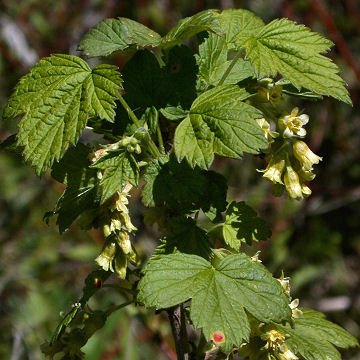

Ribes americanum - (image 1 of 5)
Taxonomy
Family: Grossulariaceae
Habitat
Moist woods, calcareous springy areas.
Associates
Distribution
New England and Eastern Canada, south to VA, west to CO, MT and adjacent Canada.
Morphology
Erect, unarmed shrub. Leaves palmately veined with 3-5 lobed, dotted below with golden glands. Flowers in drooping racemes, greenish-yellow, more than 7 mm long; pedicels exceeded by lanceolate bracts; hypanthium narrowly campanulate above the ovary. Fruit smooth, black when ripe.
Notes
Flowers mid April to early June
Wetland indicator: Facultative Wetland
Shiny, golden glands are present below the leaf but some can occur above the leaf, as seen in the last image. The fruits picture here were not yet ripe. I have not personally tried them and thus cannot attest to the palatability. The name "gooseberry" is usually applied to members of this genus with bristly fruit that remains attached to the pedicel, while the name "currant" is used for species with smooth fruit that separates easily from the pedicel.
Plants in the genus Ribes are alternate hosts for White Pine Blister Rust (Cronartium ribicola).
References
Gleason, Henry A. and A. Cronquist. 1991. Manual of Vascular Plants of Northeastern United States and Adjacent Canada. Second Ed.
The New York Botanical Garden. Bronx, NY
Peterson, L. A. 1977. A Field Guide to Edible Wild Plants: Eastern and central North America.
Houghton Mifflin Company. New York, NY
Swink, F. and G.
Wilhelm. 1994. Plants of the Chicago Region.
Indiana Academy of Science. The Morton Arboretum. Lisle, Illinois.
USDA, NRCS. 2002.
The PLANTS Database, Version 3.5 (http://plants.usda.gov).
National Plant Data Center, Baton Rouge, LA 70874-4490 USA.
|
Michael Hough © 2005 |